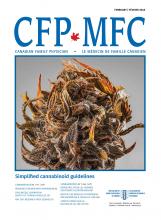Tools and Supports for Primary Care
In 2017, the ACFP with their collaboration with the PEER group, published three Tools for Practice articles.
- #199 Missing “High” Quality Evidence: Medical Cannabinoids for Pain? –
Clinical Question: Are medical cannabinoids (MC) effective for the treatment of pain?
Author(s): G. Michael Allan, Caitlin R. Finley, Robert Hauptman, Nathan P. Beahm
Publication Date: November 14, 2017 - #200 Harms of Medical Cannabinoids: Up in Smoke! –
Clinical Question: What are the harms associated with medical cannabinoid therapy?
Author(s): G. Michael Allan, Joey Ton
Publication Date: November 27, 2017 - #201 Any Other “Doobie”ous Effects of Medical Cannabinoids? –
Clinical Question: Besides pain, are medical cannabinoids effective for other conditions?
Author(s): G. Michael Allan, Jamil Ramji, Danielle Perry
Publication Date: December 11, 2017
Simplified guideline for prescribing medical cannabinoids in primary care
Abstract
Objective To develop a clinical practice guideline for a simplified approach to medical cannabinoid use in primary care; the focus was on primary care application, with a strong emphasis on best available evidence and a promotion of shared, informed decision making.
Methods
The Evidence Review Group performed a detailed systematic review of 4 clinical areas with the best evidence around cannabinoids: pain, nausea and vomiting, spasticity, and adverse events. Nine health professionals (2 generalist family physicians, 2 pain management–focused family physicians, 1 inner-city family physician, 1 neurologist, 1 oncologist, 1 nurse practitioner, and 1 pharmacist) and a patient representative comprised the Prescribing Guideline Committee (PGC), along with 2 nonvoting members (pharmacist project managers). Member selection was based on profession, practice setting, location, and lack of financial conflicts of interest.
The guideline process was iterative through content distribution, evidence review, and telephone and online meetings. The PGC directed the Evidence Review Group to address and provide evidence for additional questions as needed. The key recommendations were derived through consensus of the PGC. The guideline was drafted, refined, and distributed to a group of clinicians and patients for feedback, then refined again and finalized by the PGC.



2 Responses
Please explain to me the reason for 3 month follow up appointments to keep a medical marijuana prescription in effect, thanks.
Alan
I am not sure where you found the 3 month follow up appointment to keep a medical marijuana prescription in effect. Please let me know and I can try to help figure this out with you. The easiest way is my email: michael.allan@ualberta.ca
All the best, Mike